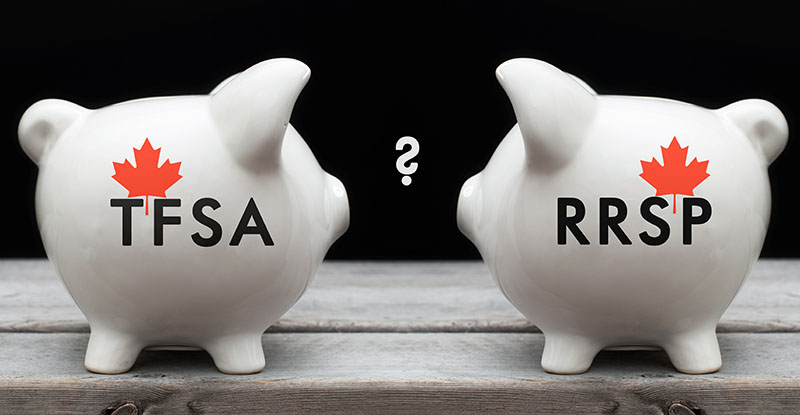
With the new year comes the start of a new tax season. As you begin to think about your financial goals and your personal income tax filing for the 2022 tax year, it’s important to be aware of how RRSPs and TFSAs can benefit you. Here are some tips that can help you use RRSPs and TFSAs to set you up for financial success in 2023 and beyond.
- Know the difference between a RRSP and a TFSA
The RRSP is a government-registered retirement savings plan that you open at a financial institution such as a bank or wealth management firm, and to which you and your spouse/common-law partner can make contributions. RRSP contributions can be used as deductions to reduce your tax annually. Any income you earn in your RRSP is usually tax exempt, if the funds remain in the plan, but you will have to pay tax when you make withdrawals (with some exceptions, such as buying your first home).
Put simply, a RRSP is a tax-deferring vehicle. The key concept here is that your income tax rate should be lower when you retire than when you are working. Therefore, you are better off seeking the benefits of the tax reduction now and paying it in retirement when your income and tax rate is typically lower.
Many are confused about the Tax-Free Savings Account, TFSA, and its purpose. The TFSA began in 2009 as a way for Canadians 18 and older to set money aside tax-free throughout their lifetime. But the TFSA isn’t just a savings account. Treat your TFSA as an investment vehicle instead. Any amount contributed and any income earned in the account, such as investment income and capital gains, is generally tax-free, even when it is withdrawn.
Remember, your RRSP contribution looks backwards and it is calculated based on your previous year's income. Your TFSA is based on a go-forward basis, but both are cumulative. The difference between the two is how you are taxed (or not taxed) when you eventually access your funds.
- Should you invest in either the RRSP or TFSA?
If you are able to, invest in both your RRSP and TFSA. In many cases, when you look at what you will get in retirement, an RRSP alone is not enough. And pension plans, depending on what company you work for, have evolved – putting more pressure on you to save for retirement on your own.
In most cases, you are better off seeking the benefits of the tax reduction with the RRSP now and paying it later. But the challenge is you don't know what your income tax rate will be in the future and you don't know what government tax rates will be overall. With the TFSA being completely tax-free, you won’t have to worry about this. In other words, if you expect to have a higher tax rate at retirement, maximizing your TFSA first may be the better option.
The contribution on the TFSA accumulates annually. For 2023, the contribution room is $6,500 and the lifetime maximum now is $88,000 if you were 18 in 2009, which is a fairly substantial amount. For younger Canadians, the maximum depends on how many years they’ve been above 18 since 2009. Treat the TFSA like a long-term investment vehicle where you can benefit from tax-free dividends and gains.
There is a new wrinkle to this ongoing debate however if you are a future first time homebuyer. Beginning in April 2023 will see the introduction of the new Tax-Free First Home Savings Account (assuming Bill C-32 is passed), which is a tax sheltered savings vehicle. This account will definitely further broaden the debate on how best to save, and divert some current savings away from TFSA’s and RRSPs for those looking to enter the housing market for the first time.
- Don’t contribute to your RRSP at the last minute
The deadline to contribute to your previous year’s RRSP is March 1. Make the first sixty days of 2023 the last time you make a lump sum contribution to your RRSP as a last-minute effort to bring down your taxes. As you enter the new season, beginning March 1, consider making a regular contribution to your RRSP if you haven’t already been.
Putting money aside for your savings or investment, such as your RRSP, is paying yourself first. Based on your budget, designate a certain amount of your pay cheque to your RRSP. To make it easier, you can set up a recurring transfer from your chequing to your RRSP. The only caveat is to ensure that all your contributions do not exceed your RRSP contribution limit. And come the next tax season in 2024, you won’t be left scrambling to find money to contribute to your RRSP.
- Maximize your TFSA
If you want to maximize your TFSA, it comes down to having a goal of what you want to achieve with your money within your TFSA and having an investment plan that suits this goal. If you use your TFSA as a savings vehicle, you can take money out and not lose the contribution room, as you can contribute back what you’ve withdrawn the following year. This is unlike the RRSP, where once you’ve withdrawn from the account, that contribution room is lost. Depending on your use of the TFSA, you may look at shorter term investments.
To reap the full benefits of your TFSA, you want to invest within your risk tolerance, which is the degree of risks you are willing to take on to achieve potentially greater rewards. That generally means looking at longer-term investment solutions, which include stocks, bonds, exchange traded funds and mutual funds. You should also try to have savings outside your TFSA to accommodate any unexpected expenses.
Historically, we have used the formula of having three-months worth of income savings readily accessible, but the pandemic has taught us that three months might not be enough. For many Canadians, aiming for more than six-months worth of savings may be wiser to avoid having to liquidate investments in a down market. You also do not want to be relying on high-interest credit cards and other loan vehicles if you can avoid it.
Jeff Brown is the Head of Wealth Management at HSBC Canada and is a CPA in Ontario.
Visit the CPABC Financial Literacy page for more helpful FinLit tips and resources.
Tax rules can be complex. This article is not intended as tax advice, and you should not make tax decisions based solely on the information presented. You should seek the advice of a chartered professional accountant before implementing a tax plan or taking a tax filing position. The views expressed by Jeff Brown are his and do not represent those of HSBC Canada.



